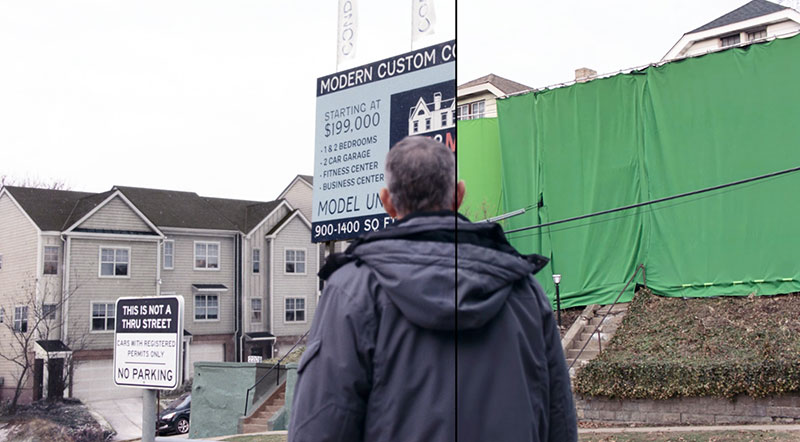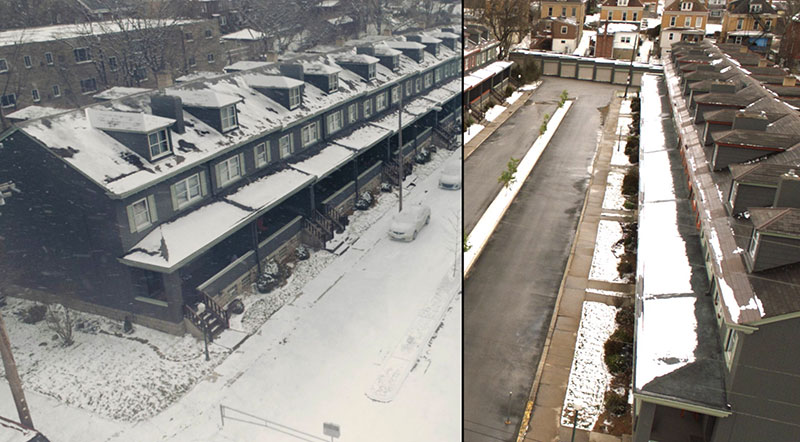Nick Drew and Simon Carr from Axis Studios talk about creating invisible VFX for environments, trains, cars and weather, all designed to keep audiences immersed in Otto’s unfolding story.

A typical request VFX teams hear from film directors and producers is to “show me something I’ve never seen before”. But for the film ‘A Man Called Otto’, Axis Studios’ job was just the reverse. The team was asked to create places many viewers have seen a bit too much of – suburban neighbourhoods, endless winter weather and railway platforms full of commuters – while turning them into photoreal settings for drama, humour and acts of kindness.
As main vendor on the movie, directed by Marc Forster, Axis delivered 250 photoreal shots that support the story with a range of invisible visual effects. Its story centres on Otto, a middle-aged man who struggles with depression, and the vital relationships he develops with his neighbours. It is based on the 2012 novel, A Man Called Ove by Fredrik Backman.
Otto’s Reality
The Axis team worked with production VFX Supervisor Janelle Crowshaw, and with VFX Supervisor Leo Bovell who worked on set. Axis Studios’ opportunity to work as lead vendor came from their previous experience with the film’s producer Fredrik Wikström on the 2020 film Horizon Line that demonstrated their expertise in photoreal VFX. Digital Media World asked Executive Producer Nick Drew and VFX Supervisor/Creative Supervisor Simon Carr about the new project.
“In this case, the brief was to create ‘invisible’ effects for environments that, while important as story points, were also essential parts of Otto’s reality,” said Nick. “We never wanted audiences to be able to tell that they were looking at a CG asset.”
The team’s many supporting effects across A Man Called Otto included digital matte paintings to extend and enhance wide shots of the neighbourhood and train station, and a small fleet of CG cars to add to various shots. As the shoot was in Pittsburg, Leo Bovell covered the on-set work and data collection for them.
Closing In
“The palette of the movie was to be quite muted to reflect Otto’s bleak view of the world, emphasised by Birchwood Estate, looming at the end of his road and giving viewers a sense of his world closing in on him,” Nick said. Birchwood, witnessed in many shots throughout the film, is a large, imposing housing estate that is encroaching on the original neighbourhood where Otto lives.

The estate was based on a real location and was LIDAR scanned, rebuilt as an entirely CG environment and reworked to fit in at the end of Otto’s street. It was made to feel monotonous and uniform to communicate the claustrophobic sense of an unfriendly world surrounding Otto. Axis Studios also modelled and textured a series of houses in blocks of three to five, which were laid out on land slightly higher than Otto’s neighbourhood to add to the sense of overbearing pressure.
Simon Carr, VFX Supervisor, said, “Since we only needed a specific set of camera angles to cover Birchwood through the film, building the entire estate wouldn’t be necessary, but we needed to build what would be seen through any particular angle very completely. Having a LIDAR scan of the location street enabled us to place blocks of houses that were consistent with the housing estate chosen as the template for the Birchwood houses.
“First, we placed simple versions into our layout scene through the different cameras and from there decided how much to build. This meant we could settle on a single master layout, keeping a little flexibility in the final render layers for tweaking.”

At the Station
In a pivotal sequence at his local railway station, Otto steps down from the platform into the path of an oncoming train. Nick said, “As the set for what was to become the station, the director had chosen a street location featuring a row of imposing iron structures that were captured in the plate with the live action. These were extended into our CG station, where we also increased the heights of the existing building, aiming to evoke that key feeling of entrapment and claustrophobia.
“Production built a station platform and section of the track, which we extended to create an elevated station with snowy tracks running far into the distance, helping to enhance the drama of the approaching trains. Alongside the usual camera and shot data from the set, we had the partial set of the station fully LIDAR scanned.”
The team worked in pre-production to plan this sequence in detail and used technical pre-vis based on the film’s script and storyboards to determine how far a train would travel at a given speed and how that would play out in shots, given the distance of the trains from Otto. By determining the timings in pre-vis, Axis imbued the scene with a sense of danger and narrative tension while maintaining a high degree of physical realism.
“In the final sequence, our trains are generally travelling at a fairly realistic speed of around 40 mph. That seemed to give the best balance between the requirements of the drama, and the believability of the time needed to react,” said Simon. “In only a few instances did we need the train to run much faster, and that was in shots using long lenses such as 100mm and 135mm, as the foreshortening effect of the lens impacts the impression of speed.”

Camera Geometry
The general angles and action of the sequence had been blocked out by production and their VFX team, and although some aspects of the environment design were adjusted through the process, the basic shots and angles remained fairly consistent throughout. The linear nature of railway tracks lends itself to particular shot positions, and keeping it simple also helps the audience’s understanding of scene geography.
For the key section around when the train nearly misses Otto, the motion blur tests relied on a more advanced model, especially with the reflective surface of the train. That meant trying a few options of speed and shutter angle, but in general, the motion blur was driven by matching the plate settings delivered from set.
Simon said, “The main keys to helping with the sense of depth in the background of shots are depth cueing – stacking atmosphere to affect the contrast further back in the frame – and parallax. Our rails did go back in 3D into the far distance, as did the ballast and snow. The deeper buildings and background elements were also projected onto geometry, which enabled any camera motion to affect the objects as it would in a real world setting.
“Getting the balance of atmosphere to help the cold, wintry feeling, and establishing depth but avoiding the whole of the distant city from becoming obscured took a few iterations. Ensuring that the defocus felt natural to the lenses was also a factor.”
Light and Weather

During production, lighting often varied enormously from day to day, causing scenes to range from bright sun to heavily overcast or even snowing weather. “Maintaining the film’s subdued, almost monotone palette and tone of the film gave the production more scope to contrast with the richer, more colourful sequences, particularly when we focus on Otto’s memories of his wife and happier times. The weather was almost a character itself and while it could not be directed, the cold, snowy overcast feel was ideal for the story,” said Nick.
The changeable weather during the shoot also required the Axis Studios team to create photoreal snow and weather effects that ensured continuity across the shoot – for example, dressing environments, evening up weather cover, adding snow to the ground or flurries of snow in the air, and adding to the on-set special effects snow to help with continuity in camera. The snow also helped to emphasise the bleak nature of Otto’s surroundings.
“Wherever possible, we tried to retain the lighting in the plate to allow the DI team the flexibility to adjust,” Simon noted. “We did some minor adjustments to the train sequence to help equalise and level the plates, since that action takes place in a relatively short space of ‘real world’ time. But for other scenes, the aim was to match our work to the plates and let the final balancing grade be done in DI.”
Chevrolet SUV

Axis Studios’ primary vehicle asset was a CG Chevrolet SUV. The brand-new car model, which Otto buys toward the end of the film, was not yet in production at the time of the shoot, and only a prototype was available as reference. The production shot with a similar stand-in model for on-set interaction with the actors, which Axis Studios replaced for the final shots.
“Having that very similar SUV in shot as reference for the plates was invaluable. Fortunately, the prototype was a full build, and Chevrolet also supplied us with extensive CAD material,” said Simon. “As the vehicle itself had been presented at car shows, we also had access to plentiful images, which showed the first build in its prototype blue. The only real difference we made between the provided data and the hero car in the film is the colour and finish of the body paint.” axisstudiosgroup.com


















